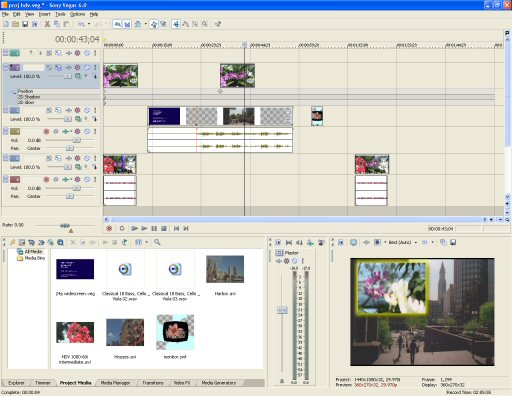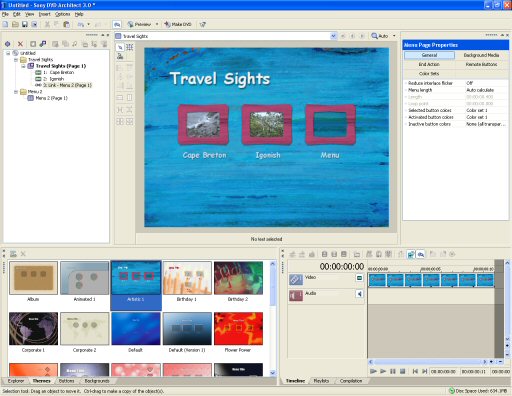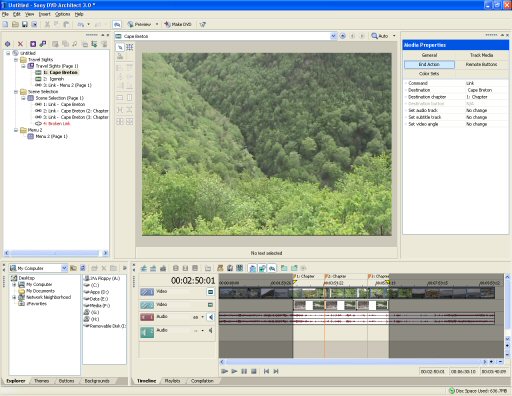Manifest Technology Blog
-- Site:
| Articles
| Galleries
| Resources
| DVI Tech
| About
| Site Map
|
Articles:
| PC Video
| Web Media
| DVD & CD
| Portable Media
| Digital Imaging
| Wireless Media
| Home Media
| Tech & Society
|
PC Video: |
PC Video Articles |
Video Software Gallery |
Video Editing Resources |
HD / HDV Editing with Sony Vegas 6
and the Vegas+DVD Production Suite (7/2005)
by Douglas Dixon
HD / HDV Editing
Audio Editing
DVD Architect
And More
References
Sony's Vegas has been a popular video editor, especially for its
extensive audio support from its heritage as a former Sonic Foundry product (mediasoftware.sonypictures.com).
The previous version, Vegas 5 (introduced in April 2004), added support for HD
editing, and significantly enhanced the associated DVD Architect 2 authoring
tool. The next step forward, Vegas 6, was introduced in April 2005 along
with DVD Architect 3, and continues these trends of flexible HD and audio
support, while also adding more professional features.
 Sony Vegas+DVD Production Suite
Sony Vegas+DVD Production Suite
Vegas has a distinctive look, with a flexible layout of multiple titled
windows. Below the main Timeline area at the top of the screen s the window
docking area, where you can easily show, hide, and resize your working windows
with splitter bars when docked together, or have multiple docked windows
floating independently as you prefer (i.e., on a second monitor). The interface
also includes a variety of distinctive (and not too tiny) icons to provide
access to controls and options (identified by pop-up tooltips, and also
accessible in the extensive right-click menus).
Vegas 6 now adds deeper support for organizing assets and managing projects.
The Media Manager is a full-up database to organize and manage media
files and associated attributes; you can tag files to assist in searching. Plus,
Vegas can import and export AAF (Advanced Authoring Format) files to exchange
projects with other applications.
You also now can nest Vegas projects (.veg files) within the timeline, and
edit them like any other clip. And Vegas recognizes imported media with embedded
project information, so you can just select Edit Source Project to open the
associated application (i.e., Sony's ACID, or another instance of Vegas) to
further edit the original project from which the media file was exported.
Let's take a closer look at the new Vegas features for HD and audio editing,
and the new professional features in DVD Architect.
Vegas is designed for editing a variety of formats, DV and SD, HDV and HD.
You can combine multiple file formats and frame rates in the same project, and
on the same track. Vegas even supports directly importing vector-based Flash (.swf)
files, which can be scaled to the project resolution to provide cool text
animations and effects.
To get started with editing in high definition, you can work with the new HDV
format and cameras (www.hdv-info.org),
including the Sony HVR-Z1U and HDR-FX1 cameras and HVR-M1OU HDV
VTR deck (www.sony.com/professional).
Vegas has project presets for both HDV resolutions, 720p (1280x720 at 25p &
30p) and 1080i (1440x1080 at 50i and 60i), and also for full HD 1080i (1920x1080
at 50i and 60i).
 HDV Editing
HDV Editing
You can capture directly from HDV devices in the raw MPEG-2 transport stream
format. However, this format is impractical for editing without a high-end
system -- the frames are compressed in what is called "long-GOP"
MPEG-2 in order to squeeze the high-definition frames down to DV tape data
rates. The frames are chunked into Groups Of Pictures (GOPs) in which the
successive frames are encoded using references to their neighbors, which means
the entire group needs to be decoded in order to provide access to each
individual frame. This can obviously be a processor-intensive nightmare when
trying to jump to arbitrary frames, or even scan forward (much less backwards).
Sony therefore recommends transcoding HDV video to an intermediate format
that is more amenable for editing, such as CineForm HD (www.cineform.com)
or Microsoft Windows Media Video HD (www.wmvhd.com).
When you deliver in HD format, you can export directly from CineForm HD
material, or replace your assets in the timeline with the HDV originals.
For other SD/HD capture, editing and export, Vegas 6 supports Blackmagic
Design DeckLink boards (www.blackmagic-design.com)
with SDI (Serial Digital Interface) and component SD and HD decks. And it
natively supports other IEEE-1394 devices, including the Sony DSR-DU1 and DSR
DR1000 DV/DVCAM hard disk recorders, and J-H3 HDCAM HD player.
Vegas runs on Windows 2000 and Windows XP Home Professional. Sony specifies a
minimum 800 MHz processor and 256 MB RAM, but for HDV recommends at last a 2.8
GHz processor and 512 MB. For example, on a 2.4 GHz test machine, Vegas played
smoothly through CineForm HDV material at 1440x1080. Then with a HDV
picture-in-picture track inserted on a HDV (or even DV) track, the Vegas preview
still played audio smoothly, but the video had visible jitters.
Beyond HD support, Vegas 6 still shines with even stronger audio
capabilities. It already had 24-bit/192 kHz audio support, with sub-mix editing
with bus routing. It provides on-the-fly punch-in recording while playing back a
project for capturing multiple takes. Vegas supports 5.1 surround mixing, and
real-time downmix previewing of audio from 5.1 surround. You can export the
individual tracks for encoding, or encode directly in Dolby Digital (not just
stereo) using the AC-3 encoder included as part of the Vegas+DVD Suite.
Vegas also provides a variety of timestretch modes to change or preserve the
clip pitch and/or length. You can use ACID loops directly in the timeline for
video scoring and audio mixing, with auto-stretching to the project tempo. You
even can pitch change ACID loops from the keyboard to modify your audio mix in
real-time.
Vegas 6 adds support for third-party VST plug-ins, and other DirectX effects
that you may have installed. These join some 30 built-in effects, including some
15 automatable effects such as Reverb, Chorus, Delay, Noise Gate, and Flange/Wah-Wah,
And Vegas now supports Broadcast Wave format files to exchange audio between
audio editors or broadcasting platforms, including metadata such as timestamps.
The timeline also now has a tape-style scrubber to scrub at various speeds
while also listening to the audio, using the mouse, JKL keys, or a multimedia
controller. Vegas also detects and repairs unaligned audio and video, comparing
grouped and overlapping media and offering to move or slip the tracks back into
synchronization.
Along with Vegas 6, the associated DVD Architect 3 authoring tool
included as part of the Sony Vegas+DVD Production Suite has added
significant professional features. In the Vegas style, it provides a nice tiled
and tabbed window display with a plethora of tools, including a Project Overview
window with a hierarchical view of menus and links, and tabs to access design
elements, DVD components, and properties.
For menu and button design, DVD Architect now supports copying and pasting
attributes, and importing entire layered Adobe Photoshop (PSD) files with the
layers tagged to define create menus and buttons with associated highlight,
frame, and thumbnail areas.

DVD Architect - Menu design
When assembling the media clips to be played on your DVD, you now not only
can have alternate audio and subtitle tracks, but also up to eight alternate
video tracks, so your DVDs can offer multiangle videos of the same event. You
not only can assemble and trim multiple clips in each track in the timeline, but
now you also can apply image-correction filters to enhance imported images and
video, including Brightness, Contrast, Colorize, and Crop.

DVD Architect - Timeline tracks
For more advanced navigation, besides more advanced button actions and menu
looping, you now can create playlists to play a sequence of clips, which means
you can reuse the same material from different parts of your navigation design
without needing to duplicate the content on disc. With DVD Architect's support
for end actions, you can set the behavior after a clip or playlist or motion
menu finishes playing, and have the DVD automatically jump to another menu or
clip, and even change the selected track.
And when creating the final disc, DVD Architect now supports burning to
dual-layer DVD+R DL discs with up to 8.5 GB of data. You also can specify a
"Jacket picture" image to be displayed when the DVD player is stopped.
Then, for creating mastering discs for replication, DVD Architect now supports
enabling copy protection options (CGMS, CSS, Macrovision, and region coding),
and exporting to the DLT, DDP, and CMF formats typically required by
professional duplicators.
Vegas has its own style and approach to video editing, and has an
enthusiastic following, especially because of its integrated support of HD
formats and broad audio editing tools. After taking over the product from Sonic
Foundry, Sony has been diligently enhancing it, especially with the more
professional features for project management and DVD authoring found in this new
version.
Vegas 6 is available separately for U.S. $599.95 (retail), or bundled as part
of the Sony Vegas+DVD Production Suite for $899.95, which includes DVD Architect
3 and Dolby Digital AC-3 encoding software for 5.1 multichannel mixes.
As a stand-alone product, Vegas 6 comes bundled with a Sound Effects
Sampler CD with 174 sound effects similar to those on the Sony Pictures Sound
Effects Series. It also includes Boris Graffiti LTD to create 2D and 3D vector
title animations, with hundreds of preset effects and styles.
The full Vegas+DVD Production Suite bundles even more software. In
addition to Boris Graffiti LTD, it includes Boris FX LTD for Vegas, a
professional-grade chroma-keyer from the full version of Boris FX, and Magic
Bullet Movie Looks HD50, which now supports HD resolutions, and provides 50
presets that mimic popular television and movie looks, especially to enhance
your DV footage to a more film-like look.
Oddly, I did run into a problem when installing Vegas on a test machine with
lots of other media applications -- it complained and then hung on start up
looking for a missing "PRM.dll" file. This turned out to be a DVD
driver component distributed with Adobe Premiere and Premiere Elements, and
Vegas 5 users had found a workaround by just copying the file to the Vegas
directory. This worked for me also, although Vegas then would intermittently
hang on starting up the Sony Media Manger database. But it was possible to
cancel the Media Manager, and then run Vegas without that component.
Similarly, Vegas tries to be helpful when opening a new project by warning
you when it cannot find some of the associated media files, although oddly when
you click on the Details button it does not actually list the offending files.
To check out Vegas for yourself, download the free trial version from the Sony
Pictures website (mediasoftware.sonypictures.com).
The download is 93 MB, and you also can download the release notes, manual, and
Vegas 6 sample projects from the Vegas CD (219 MB). The trial version is
time-limited, and support most of the product features, except for export to
certain formats that require third-party licensing (i.e. MPEG, MP3, and AC-3)
and network rendering. You also can download the trial version of DVD Architect
3 (35 MB).
Sony Pictures - Vegas
mediasoftware.sonypictures.com
HDV Information
www.hdv-info.org
CineForm HD
www.cineform.com
Microsoft - Windows Media Video HD (WMV HD)
www.wmvhd.com
Sony - HDV
www.sony.com/professional
Blackmagic Design - DeckLink
www.blackmagic-design.com
|
